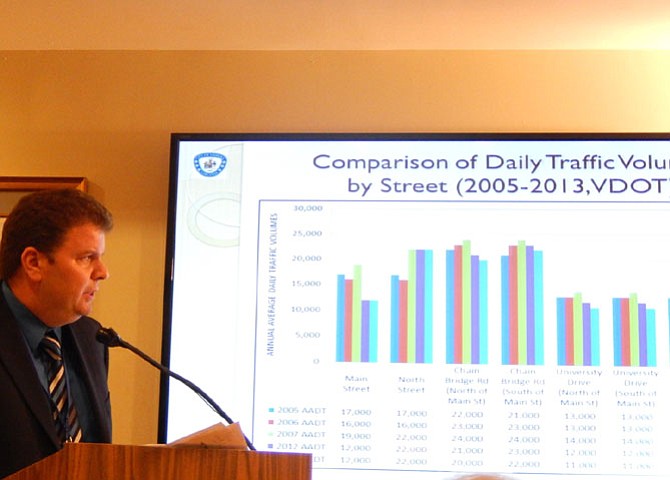Paul Silverman discusses the engineering study. Photo by Bonnie Hobbs.
To create a more pedestrian-friendly downtown area, in August 2006, the City of Fairfax reconfigured Main and North Streets from one-way to two-way. Now, though, the City Council wants to know whether it was a good decision or if it’s been detrimental to the Old Town area.
So this fall, they had an engineering study done to review the current conditions and analyze the costs and benefits of reverting back to one-way traffic on those streets. And at a recent Council work session, Paul Silverman of Sabra, Wang & Associates, which performed the study, presented the results.
“We looked at nine intersections in the Old Town area, which is primarily business and commercial uses surrounded by residential,” he said. “And a significant amount of [those] uses have come online [since the switch].”
Silverman said they examined five or six years of data and discovered that daily traffic counts on the streets – especially Main Street – generally went down 10-15 percent. North Street was the only exception.
“On North Street, up to 250 pedestrians cross there every hour, so that’s a significant increase,” he said. “Under the two-way flow, weekday evenings are when most of the traffic is on the road.”
Overall, said Silverman, “Things on the current two-way streets are better than predicted and better than they were before – although that could have to do with the decreased traffic volume.” However, he also said vehicle speeds in Old Town are up a bit.
SOME FOUR INTERSECTIONS had crashes between 2011-14, but the number of accidents has decreased every year. There were a total of 192 accidents over the past 3-1/2 years, but most were property damage only and just five involved pedestrians.
After the two-way conversion, vehicle crashes decreased at the following intersections: North Street and Chain Bridge Road, North Street at University Drive and Main Street at Chain Bridge. “This is a marked improvement in safety,” said Silverman.
But crashes at Main Street’s intersection with North and West streets more than doubled, from 11 before August 2006 to 24 since then. Crashes also rose at Main Street’s intersection with East Street/Old Lee Highway, and at Sager Avenue and University Drive. Collisions not at an intersection also rose, from 18 to 23.
“By and large, bicycles aren’t currently accommodated [in Old Town],” said Silverman. “But this area’s well-served by transit, adding to the walkability.” He said they observed congestion coming into the Old Town area, but believed parking was adequate.
“We counted 30 spaces on one street, but 1,724 off-street spaces, which is more than you’d typically see in a business district,” said Silverman. However, those doing the study included spaces at the courthouse, which isn’t convenient to all the Old Town businesses and which could be cost-prohibitive to many people.
Indeed, Councilwoman Nancy Loftus said the “off-street parking number seems large.” And that’s when Silverman said it included 558 spaces behind Panera, plus the courthouse parking lot, noting that “700 spaces [there] are either severely restricted or not available to everyone.”
Councilwoman Ellie Schmidt wondered why traffic volumes in the City were down – “if people stopped coming here, or found other routes to bypass it?” Silverman said that’s a question to explore.
“The idea was to make downtown a destination for the businesses,” said Councilman David Meyer. “We need an effective balance between traffic flow and pedestrian safety. And we need to set realistic goals for downtown and do our best to effectively manage the traffic.”
Schmidt said one of the measures of the success of the traffic-flow switch should also be “more success for the downtown businesses.” She then said she’d like to see this information.
OVERALL, though, said Mayor Scott Silverthorne, “To me, it seems like this change was successful. Pedestrian safety and accident rates are hard things to argue with.”
